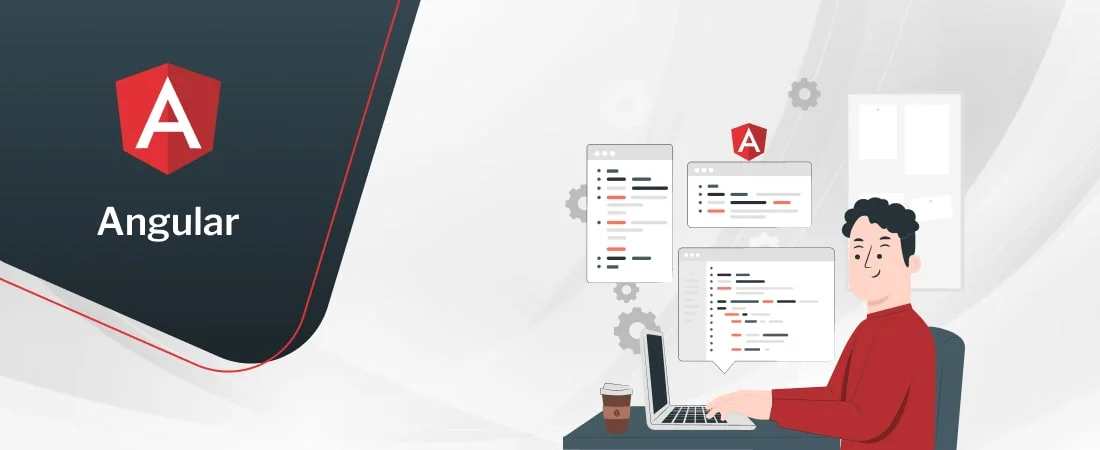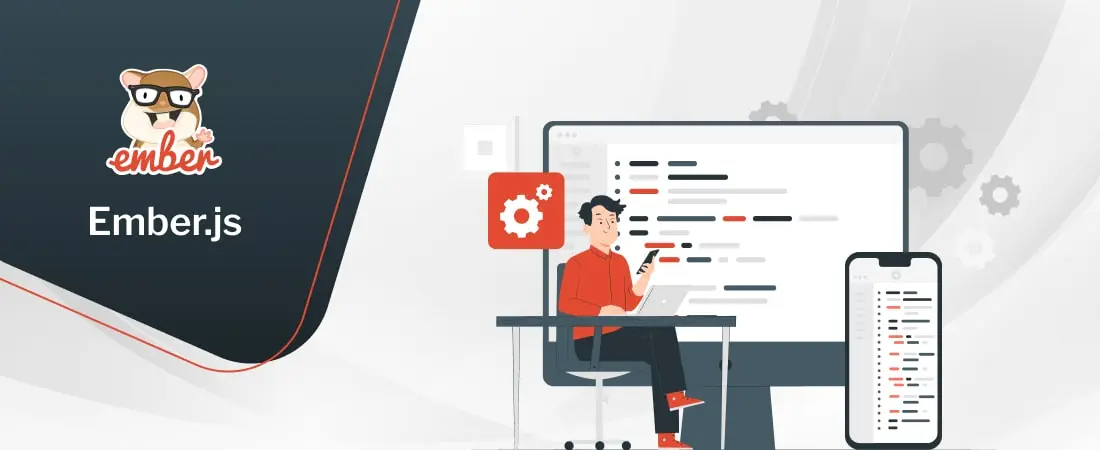Table of Content
All designs are made for user experience. Technically speaking, developers put a lot of effort into the user experience. A simple instance is that while shopping online, you visit a website, choose your favorite outfit, and pay, seamlessly through the site. Next time while thinking of buying a new outfit, you’ll again visit the same website because of the experience.
A simple cartoon you watch stays in your mind as it amuses you—the experience, what it made you feel. It is plain human psychology at play. This also applies to the website itself. But since there are plenty of different frontend frameworks to choose from for web development, let’s dive into this article and see which frontend framework is better according to your requirement.
A simple breakdown of the “Frontend” is part of web development in front of the eyes at the user end.
The best recipe for a great website is
Super simple frontend + Complex backend = Fantastic Website!
Framework – A skeletal software code that developers use to build web development projects. These prefabricated code pieces can be used multiple times to address programming tasks. They are facilitating the reusability of coding, with reduced coding time, and increased efficiency.
A framework makes maintaining and improving a web app easier over time and assists in the app development lifecycle’s prototyping, design, and implementation phases.
A framework makes maintaining and improving a web app easier over time and assists in the prototyping, design, and implementation phases of the app development lifecycle.
Instead of reinventing everything through coding, frameworks allow designers and developers to concentrate on creating a unique feature for their web-based products. A web framework prevents developers from repeatedly writing the same code to build a web application.
“People ignore designs that ignore people.”
Frank Chimero, Designer
While designing a website, the most prominent aspect is choosing “how it looks.”
When the user leaves the website, he remembers the ‘look n feel,’ translating technically into User experience (UX) and user interface (UI).
If you look at all the popular websites like Netflix, Instagram, Apple, etc., however complex the backend may be, the user interaction is super simple. This is the crucial ingredient in the recipe for a brilliant website.
Frontend development is responsible for a website or online application’s aesthetic and interactive components. It employs a range of computer languages, frameworks, and tools to make an interactive user interface and engage visitors with the help of a graphical user interface.
Making a website or application user-friendly with intuitive interfaces is a responsibility for frontend developers. They employ web-based languages like JavaScript, HTML, and CSS. They thus specialize in creating and designing websites. Frontend developers are also responsible for the designing of web apps’ user interfaces (UI) and user experiences (UX).
There are many tools you need to employ when creating an application like basic web page layouts are created using HTML; CSS handles visual formatting, and JavaScript handles interaction.
Frontend developers need to know the structure and every detail in and out of the web app. This information is conducive to the development process, whether a large-scale or small-scale application is to be designed. This information helps resolve AJAX requests as well.
Convenience is directly related to performance. Customers are ready to pay for convenience. This is how user experience tops the list of customer requirements. A complex framework will increase the execution time, furthermore leading to delays in the frontend development.
A cost-effective framework is a must for developers as well as clients. Costing affects the web development company, but eventually, it affects the pocket of the client. Let’s face it, no client likes to pay more. A cost-efficient framework with the latest features helps in giving better results.
Among other important factors, one vital aspect of website development is server-side rendering. Framework-supporting server-side rendering leads to better performance, better search engine rankings, and fast loading time, among other things.
Working on a framework requires an extended time frame. Making sure that the resources you are using will provide all the technical support needed to maintain the best working of the project is necessary.
Here we have given just small conceptual tidbits used in various frontend frameworks.
The graphic depiction of “what a viewer is seeing right now” is called DOM. Both these javascript frameworks have the application of DOM. React implements a virtual DOM, whereas Angular uses a real DOM.
Data binding is nothing but simple data sync between the Model and View. Angular makes use of bidirectional data-binding. This suggests that the output will change when input changes occur.
React uses a one-way data binding process or a unidirectional data flow method. Here updating or changing the input does not affect the output, making debugging more effortless in the unidirectional data flow process.
Sharing data between a component class and its template is referred to as “two-way data binding” and can also be called a bidirectional data binding process. Data will automatically revalue if you modify it in one location and not the other. For instance, if you change the input box’s value, the related property’s value in a component class will be updated. This automatic data modification is a bidirectional data binding process.
The ability to add functionality to components at runtime is known as dependency injection. Unlike React, Angular may have distinct life cycles for various stores since it offers dependency injection.
Since the entire list is not loaded at once, the user can view only the visible DOM elements, and as they scroll, the following lineup of visible DOM is displayed. This results in a quicker experience because the entire list is not loaded all at once but as needed to make it visible on the screen.
a.k.a Model View Controller, it creates web-based applications. MVC is popular because it makes it easier to separate concerns and isolates the application logic from the UI layer.
A single-page application (SPA) is one where most of the content is unchanged, and only a portion is updated.
For instance, when you navigate through your email, you’ll see only a few changes – the sidebar and header stay the same as you read through your inbox. The best example is when you use Gmail.
With each click, the SPA only provides the information you need, which is then rendered by your browser. This is distinct from a typical page load, in which the server sends your browser a freshly rendered entire page for each click you make.
There are multiple alternatives available in the market when it comes to frontend framework for web app development. We can confirm that React is the most widely used front end framework by looking at the graph (above mentioned). But there are other options available.
The list of best frontend frameworks that follows examines each one’s advantages and disadvantages to help you decide which frontend framework to use and when.
Here are the ten best frontend frameworks

The most popular frontend framework is created by the Meta community. An open-source JavaScript library called React. React is frequently used to build SPAs; and the user interfaces are built from different components. It is the most popular frontend framework, according to the survey on Statista.
Statista study showing most popular frontend frameworks
React supports web and mobile application development. It functions on the “View layer” within the MVC architecture for developing mobile apps and web applications. React is an open-source framework.
It is possible to build sophisticated programs using this adaptable javascript framework along with additional supporting libraries.
| Pros | Cons |
| Easy to Learn | A substantial amount of boilerplate code |
| Virtual Document Object Model | Frequent updates in the codebase |
| Scalable framework as compared to Angular | Requires additional learning about supporting libraries |
Suitable to use when creating interactive single-page applications and progressive web apps. It is known to develop user-interactive apps within a short time frame.
When Javascript is not your forte, learning React without having a command over Javascript can land you in soup. Because React is built on Javascript extension, having the upper hand on Javascript, you can easily slip into React’s shoes.

A Google team created the Typescript-based, open-source and web app development framework, Angular. Using TypeScript and HTML, the frontend framework facilitates the development of SPAs. The same Google developers who created AngularJS in 2010 also created Angular in 2016.
However, a significant development community regularly updates and supports the Angular framework. Angular is an open-source js framework.
|
Pros |
Cons |
| Multiple In-built libraries | A very steep learning curve |
| Used to create dynamic web apps | Heavyweight codebase |
| Cross-platform capability to mimic native apps | Complexity owing to in-built libraries, |
| Faster load time, High performance | Complex dynamic apps may lag |
Angular is a good fit for complex high-performing web applications and developing enterprise-level web applications and developing web applications having complicated structures. Angular proves to be the complete dynamic solution to complex projects.
When the web developer has no hands-on experience with Angular, Angular is a complex framework that executes best at large-scale applications. In small-scale applications, Angular resources are only utilized partially.

Vue.js is a simple yet progressive frontend framework. The smaller size allows it to have features like Virtual DOM and two-way data binding. Vue.js component-based architecture is ideal for building lightweight (almost 20 KB)user interfaces. Being lightweight also implies it is smaller in size.
A three-component architecture: A template(like HTML), styles, and Javascript.
A simple and straightforward framework that is compact and has an intuitive user interface.
|
Pros |
Cons |
| A component-based architecture consisting single file based on HTML, CSS, and Javascript | Confined scalability |
| Easier integration due to smaller sized components | A significantly smaller community as it is an emerging framework |
| Simple syntax | Unavailability of proper documentation in other languages except for Chinese |
Being a flexible framework with easy integration into existing components, Vue can be a suitable option for single-page web applications. Simplicity, smaller size, and lightweight dress are some of Vue’s attributes that make it a favorite choice for developers.
The phrase “language is a barrier” proves true in Vue’s case. Most of the documentation is in Chinese, which is a limitation for other language speakers. But then, no limits can stop any person from being willing to learn. So, make it a point to hire experienced developers.

It is an effective and independent javascript framework for building large-scale applications. An impressive CLI for generating code and managing dependencies in Ember.js. Some of the other standout features are its component based architecture and two way data binding which gives it resemblance to Angular.
Most challenging to implement and one of the most ambitious frameworks. However, most developers use it because it is simple to create complex applications in this framework.
|
Pros |
Cons |
| A tool called Ember Inspector to debug apps | Like the attributes, the learning curve also resembles Angular. A steep learning curve |
| Built-in router for URL management | Complex syntax |
| Backward compatible, i.e., the older framework versions will also work without glitches. | Due to its complexity, it is a lesser-known framework for smaller communities. |
They are used for large-scale projects. Companies like LinkedIn and Apple rely on Ember for their big projects due to its ease of use.
Simple and small projects waste resources for such a heavyweight framework. Not suitable for them.

One of the first and most well-known frontend frameworks, jQuery, was introduced in 2006. It is technically a library, but it also matches the framework concept. Consequently, many frontend developers still view it that way—a quick and lightweight JavaScript toolkit for traversing and manipulating HTML documents, event handling, and animation.
Jquery is a cross-platform and cross-browser library, meaning can develop a web app on any operating system and any browser, for that matter.
| Pros | Cons |
| Large technical community | Slower than other frameworks |
| Responsiveness | Old and outdated APIs |
| Great browser support | Performance issues for large applications |
When the frontend developer has to add animation and interactive components to your existing website, its rich user interface is a brownie point for the web developer. This framework can be used to develop small-scale applications.
Not a suitable pick for large, company-level applications due to excess coding in Javascript.
Yes, Make Your Business Scalable with Frontend Web Technology. Partner with Moon Technolabs for custom-made frontend web applications.

Semantic UI is one of the top frontend frameworks for web development and is powered by jQuery and LESS. The initial idea was to build it around organic code. The quality that attracts developers to opt for Semantic UI is its simplicity.
Among others are its intuitive user interface which makes semantic UI a successful framework made of organic code. Its integration with various third-party libraries, faster web and app development procedure, and other great features make semantic UI an excellent development platform—a suitable replacement for Bootstrap.
| Pros | Cons |
| Responsive UI components | Knowledge of customized configuration |
| Organic code | Very few recent updates have been released |
| Toolset allows a plethora of themes | Proficiency in Javascript is a must, not for beginners |
If you want to build a web app with Elegant, seamless, interactive UI designs, Semantic UI is the best frontend framework to pick from the basket. Much more suitable when the web development project needs multiple themes.
Good know-how of Javascript is needed.

A compact and adaptable frontend library is Backbone. Backbone was created by the same person as Underscore.js and CoffeeScript. It is an open-source JavaScript toolkit for creating single-page applications (SPAs) and giving structure to online applications based on the Model-View-Presenter (MVP) design paradigm.
The event-driven architecture and seamless integration with other libraries and frameworks are two of Backbone’s primary advantages. Simple e-commerce websites and social networking platforms are among the small- to medium-sized apps that may be built with Backbone that need flexibility. Utilized for more extensive projects when better design and less code are required
| Pros | Cons |
| Very well-structured applications | Limited framework functionality |
| Easy to learn | It does not offer Two-way data binding |
| Data storage as models | Very fuzzy, ambiguous architecture |
Ideal for creating applications that need to handle changes dynamically, synchronize servers and clients continuously, etc. The codes are simple to reuse and update.
This framework does not cater to the “Everything under one roof package“. It is a minimalist framework which requires extensions and plugins to be downloaded for various projects.

Tiny React is Preact as Tiny as 3KB. React and Preact share the same APIs. The difference is that Preact is smaller in size, hence Tiny React. Preact renders the quickest and slimmest virtual DOM library.
It can be used directly in the browser and is compatible with other libraries. It is a js framework. The objective is to deliver the best functionality to frontend developers while keeping the framework size as small as possible.
| Pros | Cons |
| Small size and efficient | Compact size lacks some features as compared to React. |
| Easy to learn | Not much documentation is available |
| Simplistic APIs | Works with ES6 elements only |
Perfect for designing simple landing pages. Best for conditions like limited storage space and slow internet connection speed. While developing a web app if you want to consider the app’s performance, size, and speed, switching to Preact is a good decision. Uber is one of the companies that made the switch to its progressive web app.
Not advisable if a complex app is something you are aiming for your next project. Heavyweight apps are not suitable on Preact.

Svelte is a “ready to use cybernetical product“ that is more of a compiler that turns declarative elements into plain JavaScript that has been surgically changed to be highly efficient. Unlike Js frameworks like Vue and React, which function in users’ browsers while the apps are running, this approach is unique in the UI development world.
One of the significant features of Svelte is its fast development process. It simplifies the process of development by swiftly building less resource-intensive applications.
Svelte is a freshman in the application development university with a stable version released in 2021.
| Pros | Cons |
| Fast development process | Limited functionality due to its limited maturity |
| Stable and high performing | Smaller community support |
| Good for beginners |
Ideal for small-scale projects. Suitable for beginners as it uses simple syntax and coding. Suitable for projects with limited time frames as it is a fast development process.
Not suitable for large-scale projects with complex features. Due to its immature community age and limited functionality it requires more time to grow up. It requires multiple plugins and extension downloads.

A dependable alternative to Bootstrap. Rapid, dynamic features, a lightweight segment for mobile apps, and seamless transitions and animations are all part of the foundation framework. Some of the biggest tech companies like NatGeo, Mozilla are currently implementing this frontend framework. The ideal blend of elements makes it every developer’s dream framework.
The primary features include a vast pre-built UI components library, grid system, and cross-browser compatibility.
| Pros | Cons |
| Brilliant GPU acceleration | Demanding and arduous framework to learn |
| Enormous library of pre-built components | Heavyweight codebase |
| Flexibility in grid usage | Smaller community |
Websites which require responsive user interfaces can opt for the Foundation framework. Flexibility is another feature of this framework. So it is best suited for a responsive and flexible application or website.
Beginners should refrain from using this complex, heavyweight framework to start. The syntaxes are complex to pick up.
Your website is your first impression to all the visitors. Get a website with MoonTechnolabs to skyrocket your business.
We have presented you with weighted options of the ten most popular frontend frameworks to assist you in picking the suitable alternative for your project. There are a multitude of options to work with when considering the frontend framework. But it all depends on what the project demands, what the client is asking for and the skills of your developers.
The variation fans from large-scale to small-scale frontend frameworks. Heavyweight codebase to as light as 3KB codebase as well. These frontend frameworks discussed here are easy to learn and require just as much effort as to spell “framework”. The choice is yours depending on the factors.
The detailed guide here is intended to let you get acquainted and weigh all the available alternatives. If you cannot pick from the bouquet, Moon Technolabs is a well-known company in the app development market. We have multiple solutions to fit your query.
01
02
03
04
05
Submitting the form below will ensure a prompt response from us.